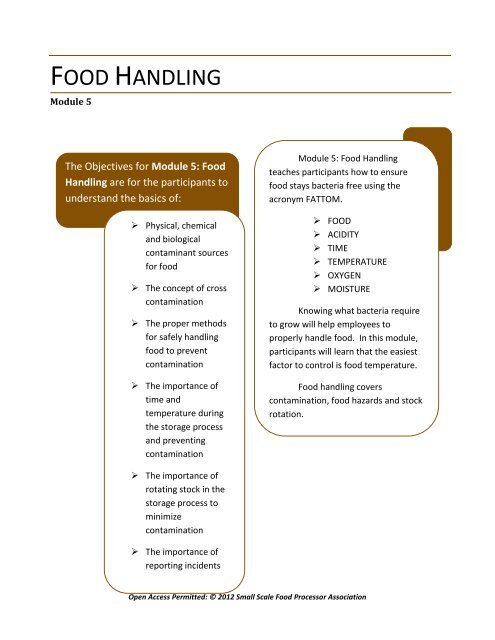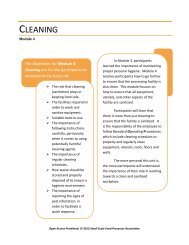Food Processing - Manual 5 - Small Scale Food Processor Association
Food Processing - Manual 5 - Small Scale Food Processor Association
Food Processing - Manual 5 - Small Scale Food Processor Association
Create successful ePaper yourself
Turn your PDF publications into a flip-book with our unique Google optimized e-Paper software.
<strong>Food</strong> Handling: Module 5ContaminationIn Module 1, participants wereintroduced to the term contamination.Contamination is the presence of hazards infood that could cause injury or death.Hazards include chemicals, foreign materialsor physical hazards which could cause manypeople to become ill.The three types of food hazards are:‣ Physical: such as hair‣ Chemical: cleaning agents‣ Biological: microbesReview the three kinds of foodhazards: chemical, physical and biological.‣ Have participants draw an example ofeach.‣ Participants can discuss in smallgroups and identify as many foodhazards as they can in a set timeframe.‣ Using a variety of pictures of foodhazards, have participants classify thehazards into one of the threecategories.Activities2
<strong>Food</strong> Handling: Module 5Physical HazardsThis was covered in Module 1. Usethe time to review the physical hazardsshown.Physical hazards or contaminants areany potential harmful extraneous matternot normally found in food.Challenge participants to think ofother examples of physical hazards that arenot included in the slides.Other examples‣ Jewelry‣ Eyeglasses‣ Fabric‣ Medication‣ <strong>Food</strong>‣ Plastic utensils‣ Pens3
<strong>Food</strong> Handling: Module 5Chemical HazardsPesticides should be identified in thecompany’s HACCP plan. Employees should beaware that pesticides can be possiblechemical hazards and therefore fruit andvegetables should be properly cleaned.Cleaning agents are also chemicalhazards. In Module 3, participants viewedNanaimo’s SalsaMan’s good sanitationprocess. Chemicals are used to sanitize theequipment and processing surfaces. Thesecleaners and sanitizers are designed toremove contaminants and then to be rinsedoff. If chemicals and sanitizers are notproperly rinsed off, they can enter the foodand pose a chemical hazard to consumers.Biological HazardsA microbe is a microscopic organism,such as a bacterium, virus or parasite(excluding the large ones). Microbes are sosmall that you need to use a microscope andspecial staining techniques to see them. Theword microbe is often more convenient to usethan the word microorganism, and it prettymuch means the same thing. In manysituations, though, microbe refers to just theharmful microorganisms (the ones that causedisease), whereas microorganisms refer to allmicroscopic life.(SSFPA, unknown)4
<strong>Food</strong> Handling: Module 5Sources of Biological HazardsEmployees create the greatest risk ofpotential food hazards. Bodily fluids that enter afood source are biological hazards.Employees are only one source biologicalhazards. Other sources of biological hazard cancome from flies and pests. Employees should beprepared to let their supervisor know if they seeinsects or pests in the food processing facility.If preparing an employee for a specificfood processor, ask the supervisor what the planis for pests and insects in the processing plant.Active LearningRole PlayContact a local high school orcommunity college sciencedepartment and ask to borrowmicroscopes and slides of microbes.Engage participants in looking atsome of the microbes that could befound in their food.Have participants practicetelling their supervisor about apotential biological risk.‣ Role playing is one way topractice‣ Practicing speaking the wordswith a partner will also helpparticipants who may strugglewith talking with theirsupervisor.5<strong>Food</strong> Poisoning
<strong>Food</strong> Handling: Module 5Cross ContaminationCross contamination was firstintroduced in Module 1. Review theconcept with participants.‘‣ Have participants discuss theexperiment they tried with inkand paper. If you have not donethis activity, refer to Module 1and complete the activity now.Traffic PathsHave participants create a blueprint of theirworkplace (or have one prepared). Using theblueprint, participants will highlight their usualtraffic pattern. Have participants think about whatthey regularly touch (utensils, door knobs andboxes). Have participants draw stars (or use starstickers) to identify where cross contamination hasthe highest risk.6
<strong>Food</strong> Handling: Module 5<strong>Food</strong> PreparationSalmonella is a common microbe. Acommon source of contamination occurs whenan employee prepares raw meat and thenprepares vegetables on the same surface withoutproperly cleaning and sanitizing the surface.Practice using different cuttingboards for preparing raw meat and rawvegetables.Active LearningPractice cleaning and sanitizingsurfaces between preparing different foods.Practice is the key to learning!7
<strong>Food</strong> Handling: Module 5FATTOMThe next few slides will explainthe six things bacteria need to growand multiply.FOODACIDITYTEMPERATURETIMEOXYGENMOISTURE<strong>Food</strong>Bacteria need a source ofenergy to help them multiply.<strong>Food</strong>s that contain proteinsrepresent the largest risk.Such as: meat, poultry, dairyproducts and eggs.9
<strong>Food</strong> Handling: Module 5AcidityBacteria need their environment to bewithin a specific pH range. Bacteria need aneutral pH to grow which is between 4.6 and7.5 pH. Acidic foods usually inhibit growth.Acidic foods include most fruits, pickles, andvinegar.Active LearningAs acidity may be a new term for manyparticipants, taking the time to use Litmus strips(found in local pool stores) and testing the acidityof different foods and drinks may be aninteresting activity.To use Litmus strips, dip the tip the stripinto liquid of the food or drink you want to test.Let the strip dry.The colour of the dry strip tells you if thefood or drink is acidic or alkaline.Red strip = acidic food or drinkBlue/purple strip = alkaline food or drinks10
<strong>Food</strong> Handling: Module 5TemperatureHow to regulate temperature‣ Cook to a high temperature‣ Cool foods quickly‣ Keep food out of the cooler foronly a short time‣ Keep all coolers at the correcttemperatureEvery food is either:‣ Shelf stable and stored at roomtemperature‣ Requires refrigeration‣ Is kept frozenThermometersKeeping record of temperaturesof coolers will require an understandingof how to read thermometers. Bring ina variety of thermometers both digitaland mercury style and have participantspractice reading the temperature.If you don’t have access to afridge, pour water into jugs and add icecubes or hot water to have a variety ofdifferent temperatures.11
<strong>Food</strong> Handling: Module 5TimeTime is as important a factor as temperature is.Given the correct temperature, microbes canmultiply rapidly. This will dictate how longcertain foods can be stored and processed.Refrigerated food (0 40 C/32 to 40 F) can bestored between 1-7 days depending on food.Frozen food (-18 C/ 0 F) can be stored between1-6 months depending on food.Dry food (10 to 21 C/ 50 to 70 F) can be storedbetween 4-24 months depending on food.Bacteria grow by multiplying. When conditionsare right, they can double every 20 minutes.Potentially hazardous food left in the DANGERZONE can grow enough to cause food borneillness. People who are elderly, very young,pregnant or immuno-compromised can becomeill from even fewer bacteria. Be safe: throw itout!(British Columbia FOODSAFE Secretariat, 2006)12
<strong>Food</strong> Handling: Module 5OxygenBacteria need oxygen to grow. <strong>Food</strong> in canshave been vacuumed sealed, once a can has beenopened, there is risk for bacteria to grow.What do participants do at home when theyopen a can of food at home but don’t use all of it?What should participants do with an open can offood?<strong>Food</strong> should be removed from cans andplaced in a clean and sanitized container once a canhas been opened.Bacteria also need moisture to grow.Participants should be aware of common sources ofmoisture in a food facility. Dish clothes and mopsthat are damp are moist and are ideal areas forbacteria to grow and present an opportunity forcross contamination.Moisture13
<strong>Food</strong> Handling: Module 5Preventing ContaminationHave participants think aboutwhy it matters how food is stored?Responses will vary.If food is not stored in an appropriatelycontrolled environment, spoilage (i.e.microbial growth, toxin formation) canoccur. If ingredients, food containersand packages are not protected duringstorage, contamination from microbes,chemicals and foreign matter can occur.Personnel having open cuts or woundsdo not handle exposed food,ingredients, packaging materials or foodcontact surfaces unless measures aretaken to prevent direct or indirectcontamination of food.Active LearningHave participants practice coveringfood with lids, plastic wrap, and movingfrom cans to another sanitized container.14
<strong>Food</strong> Handling: Module 5Rotate <strong>Food</strong>Ask participants if they have everwitnessed a store employee stockingshelves. Discuss how a store employeewould take the food at the back andmove it to the front. Also discuss howthe employee would be checking thebest before date to ensure the food isstill good.Active LearningBring in a variety of food productsthat have expiry dates on them. Haveparticipants order the food based on theexpiry date. <strong>Food</strong>s with the closestexpiry date would be the first in the lineas it would need to be the first to go.15
<strong>Food</strong> Handling: Module 5FIFOEmployees need to be aware ofthe established procedures for theappropriate rotation of food, ingredientsand packaging materials (i.e. First In,First Out) to prevent or minimize foodproduct contamination, damage orspoilage (e.g. corrosion resulting inleakage, shelf-life expiration).Active LearningTake a trip to a local grocery storeand have a store employee showparticipants how they stock shelves usingthe First In, First Out policy.16
<strong>Food</strong> Handling: Module 5Damaged packagingEmployees are responsible forletting their supervisor know aboutpotential food hazards. If packaging hasbeen damaged in transit or becomesdamaged in the food processing facility,employees should notify their supervisorbefore using the product.17















